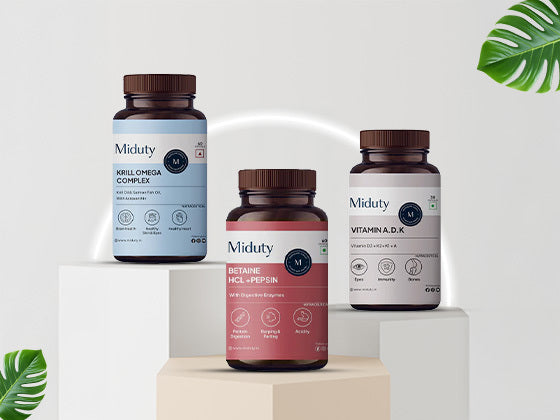Cysteine hair treatments, also known as cysteine straightening or smoothing treatments, are becoming increasingly popular as a semi-permanent solution for frizz control, volume reduction, and smoother, more manageable hair. This blog discusses six advantages and disadvantages of cysteine hair treatments, as explained by an expert.
Cysteine Treatment Unveiled: What You Need to Know
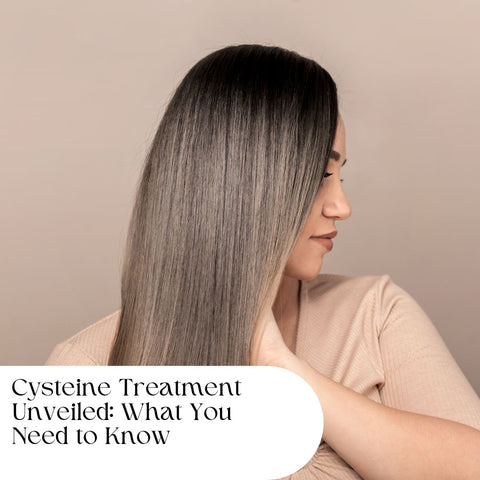
Cysteine hair treatment, also known as cysteine straightening or smoothing treatment, is a semi-permanent treatment that improves the texture, manageability, and appearance of hair. Cysteine treatment can be an effective option for people looking to improve the texture and manageability of their hair. With proper care and maintenance, it can help you achieve smoother, healthier-looking hair without using harsh chemicals like traditional straightening treatments.
The Science Behind Cysteine Hair Treatments
Cystine hair treatments offer a versatile and relatively gentle option for achieving smoother, more manageable hair without the harsh chemicals associated with traditional straightening treatments. However, it's essential to consult with a professional stylist and follow proper aftercare instructions to ensure optimal results and minimize the risk of damage to the hair.
Comparing Cysteine and Keratin: Which is Right for You?
The choice between cysteine and keratin treatments is based on your hair type, desired results, and personal preferences. Here's a comparison to help you decide which option might be best for you:
Cysteine Treatment:
-
Definition: Cysteine treatments rely on the amino acid cysteine to break and restructure the disulfide bonds within the hair's protein structure, resulting in smoother, more manageable hair.
-
Benefits: Cysteine treatments help to reduce frizz, tame unruly hair, and improve manageability. The treatment can improve the overall condition of the hair, adding shine and softness. Cysteine treatments gradually fade over time with repeated washes, typically lasting for several weeks to a few months. Cysteine treatments are generally considered safe for most hair types, including color-treated and chemically processed hair.
-
Considerations: Cysteine treatments are typically milder than traditional keratin treatments, making them suitable for individuals with sensitive or damaged hair. While rare, some individuals may experience scalp irritation or allergic reactions to the treatment solution.
Keratin Treatment:
-
Definition: Keratin treatments involve applying a keratin-rich solution to the hair, which is then sealed in with heat to smooth and straighten the hair.
-
Benefits: Keratin treatments effectively straighten hair, reducing curl and volume for a sleeker appearance. Keratin treatments can last for several months, providing long-lasting results with proper care and maintenance. Keratin treatments help to eliminate frizz and create a smoother, more polished look. The keratin in the treatment helps to strengthen and fortify the hair, reducing breakage and damage.
-
Considerations: Some keratin treatments contain formaldehyde or formaldehyde-releasing agents, which can emit fumes during the treatment process and may be irritating to some individuals. Keratin treatments can be more damaging to the hair than cysteine treatments, particularly if the hair is over-processed or if the treatment is applied incorrectly. Keratin treatments may not be suitable for all hair types, particularly fine or thin hair, as they can weigh down the hair and make it appear limp.
Ideal Candidates for Cysteine Hair Treatment
Cysteine hair treatments may be an appropriate option for individuals looking to achieve smoother, more manageable hair without the harsh chemicals associated with traditional straightening treatments. However, before beginning the treatment, you should consult with a professional stylist to determine your hair type, condition, and treatment goals.
Weighing the Benefits: How Cysteine Transforms Your Hair
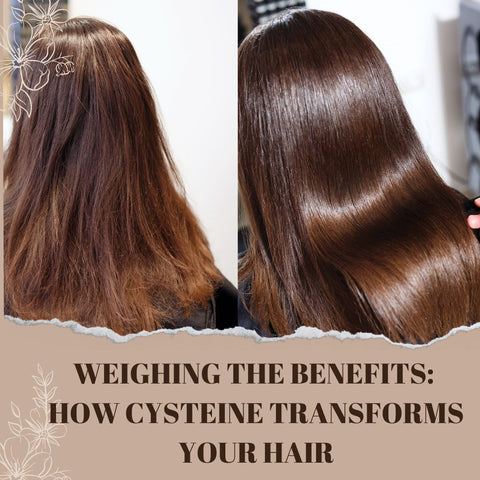
Cysteine hair treatments provide numerous benefits that can improve the texture, appearance, and manageability of your hair. Here's how cysteine affects your hair:
-
Smoothing and Frizz Reduction: Cysteine treatments smooth the hair cuticle, reducing frizz and giving the hair a sleeker, more polished look. This is especially beneficial for people who have curly, wavy, or frizzy hair and struggle to manage the texture.
-
Softening and Conditioning: Cysteine treatments include conditioning agents that soften and hydrate the hair, improving its texture and appearance. The treatment can leave your hair silky smooth and touchably soft.
-
Straightening and Relaxing: While cysteine treatments are less intense than traditional chemical straightening treatments, they can help loosen curls and waves, resulting in a straighter and more relaxed hair texture. This can make styling more convenient and reduce the need for daily heat styling.
-
Long-Lasting Results: Cysteine treatments produce semi-permanent results that fade over time with subsequent washes. The treatment's effects, however, can last from several weeks to a few months, depending on the individual's hair type and maintenance regimen.
-
Color-Treated Hair Compatibility: Cysteine treatments are generally safe to use on coloured or chemically processed hair. The treatment can improve the vibrancy and longevity of hair colour, making it an excellent choice for people who have coloured or highlighted hair.
-
Styling Versatility: After a cysteine treatment, your hair will be easier to manage and more versatile. You can wear it straight, wavy, or curly, depending on your personal preferences and desired look.
-
Reduced Styling Time: Smoother, more manageable hair requires less styling and taming each day. This is especially useful for people with busy schedules who want a low-maintenance hair care routine.
-
Healthier-Looking Hair: Cysteine treatments can improve the overall health and appearance of hair by adding shine, softness, and vibrancy. The treatment's conditioning properties help to nourish and strengthen the hair while reducing breakage and damage.
From Frizz to Fabulous: The Transformative Effects
Cysteine hair treatments can effectively transform frizzy, unruly hair into smooth, fabulous locks. Here's how these treatments produce their transformative effects:
-
Frizz occurs when the hair cuticle is raised, allowing moisture to enter and expand the hair shaft. Cysteine treatments help to smooth the hair cuticle, seal it, and keep moisture from penetrating the shaft. This results in less frizz and more manageable hair.
-
Cysteine treatments condition and nourish the hair, leaving it silky smooth and shiny. The treatment boosts the hair's natural lustre, giving it a healthy and radiant look.
-
One of the most significant advantages of cysteine treatments is easier hair management. The treatment smoothes the hair cuticle and reduces frizz, making it easier to style and control. It reduces tangling and knotting, allowing for easy styling and a polished appearance.
-
Cysteine treatments provide numerous styling options. Whether you prefer sleek and straight hair or soft and natural waves, the treatment will help you achieve your desired look with ease. It serves as the foundation for a variety of hairstyles, allowing you to change your style as you see fit.
-
While cysteine treatments are semi-permanent and fade over time, they produce longer-lasting results than other temporary smoothing solutions. You can enjoy smooth, frizz-free hair for a longer time with the treatment's effects, which can last for several weeks to a few months with proper care and maintenance.
-
Treatments with cysteine not only make hair look better, but also make it healthier and more vibrant overall. By strengthening and nourishing the hair, the conditioning agents in the treatment lessen breakage and damage. The hair gets stronger, healthier, and less prone to frizz and dryness over time.
-
Your gorgeous, smooth locks can dramatically boost your self-esteem and confidence when your frizzy, unruly hair is transformed. Whether you are attending work, interacting with people, or enjoying special occasions, having your hair look its best will give you a boost of confidence and empower you to tackle the day.
Longevity and Maintenance: Getting the Most Out of Your Treatment
Maintaining and caring for your cysteine hair treatment is critical to ensuring its longevity and efficacy. Here's how to make the most of your therapy:
-
Sulfates can strip the hair of its natural oils and may cause the cysteine treatment to fade more quickly. Choose sulfate-free shampoos and conditioners that are gentle on your hair and will not jeopardise the treatment's effectiveness.
-
Washing your hair too frequently can speed up the fading of the cysteine treatment. Try to wash your hair every 2-3 days or as needed, and use dry shampoo in between washes to refresh it if necessary.
-
When washing your hair, use lukewarm water rather than hot water, as hot water can open the hair cuticle and cause the treatment to fade faster. Finish with a cool water rinse to seal the hair cuticle and add shine.
-
Leave-in conditioners or serums designed for frizz control and heat protection can help to keep hair hydrated and smooth. These products can help to extend the benefits of the cysteine treatment and keep your hair looking smooth and shiny.
-
Excessive heat styling can weaken the hair, causing the cysteine treatment to fade faster. To prevent hair damage, use flat irons, curling irons, and blow dryers sparingly or on low heat settings.
-
Sun exposure, humidity, and pollution can all have an impact on how long your cysteine treatment lasts. When spending time outside, wear hats or apply UV protectant sprays, and in humid climates, consider using anti-humidity products to combat frizz.
-
Depending on your hair type and treatment results, you may need to schedule touch-up appointments every few months to keep your hair smooth and manageable. Consult with your stylist to determine the best time for touch-ups based on your specific needs.
-
Chlorine from swimming pools and saltwater from the ocean can dry and damage hair, causing the cysteine treatment to fade faster. To reduce exposure while swimming, wear a swim cap or rinse your hair with fresh water before and afterward.
By incorporating these maintenance tips into your hair care routine, you can increase the longevity of your cysteine treatment and keep your hair looking smooth, shiny, and fabulous for longer. Regular maintenance and proper care are essential for getting the most out of your treatment and maintaining its effects over time.
Cost vs. Value: Is Cysteine Treatment Worth the Investment?
Deciding whether cysteine treatment is worth the investment depends on various factors, including your hair type, lifestyle, budget, and personal preferences. Here's a breakdown of the cost versus the value of cysteine treatment to help you make an informed decision:
Cost Factors:
-
The cost of a cysteine treatment can vary depending on factors such as the length and thickness of your hair, your location, and the salon or stylist performing the treatment. Generally, cysteine treatments may range from moderate to high in cost compared to other salon services.
-
While cysteine treatments are semi-permanent and gradually fade over time, you may need to invest in touch-up appointments every few months to maintain the results. Consider the ongoing cost of touch-ups when evaluating the overall expense of the treatment.
-
To maximize the longevity of your cysteine treatment, you may need to invest in sulfate-free shampoos, conditioners, and styling products formulated for chemically treated hair. These products can help preserve the results of the treatment and prolong its effects.
Value Considerations:
-
Cysteine treatments can transform frizzy, unruly hair into smoother, more manageable locks. The treatment reduces frizz, softens the hair, and enhances shine, resulting in healthier-looking hair that is easier to style and maintain.
-
While cysteine treatments are not permanent, they provide longer-lasting results compared to other temporary smoothing solutions. With proper care and maintenance, the effects of the treatment can last for several weeks to a few months, allowing you to enjoy smooth, frizz-free hair for an extended period.
-
Cysteine treatments offer versatility in styling options, allowing you to wear your hair straight, wavy, or curly, depending on your preferences. The treatment provides a solid foundation for various hairstyles and reduces the need for daily styling and touch-ups.
-
By reducing frizz and improving manageability, cysteine treatments can save you time and effort in your daily hair care routine. You'll spend less time styling and taming your hair, allowing for a more effortless and streamlined beauty routine.
-
Transforming frizzy, unruly hair into smooth, fabulous locks can have a significant impact on your confidence and self-esteem. With your hair looking its best, you'll feel more confident and empowered to take on the day, whether at work, socializing, or enjoying special occasions.
Navigating the Cons: Considerations and Cautions
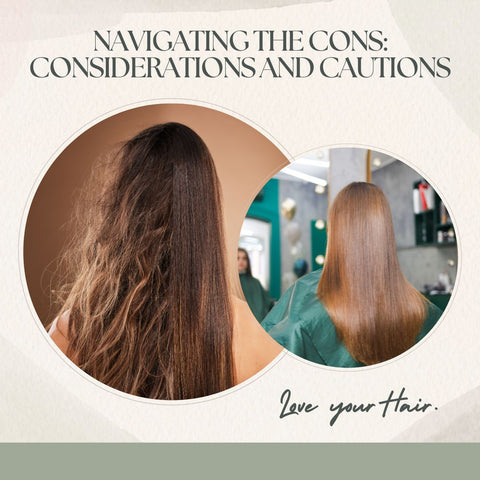
While cysteine hair treatments have numerous advantages, it is critical to consider the potential drawbacks and exercise caution to ensure a positive experience. Here are some considerations and warnings to keep in mind:
-
Scalp Sensitivity: Some people may develop scalp irritation or allergic reactions to the cysteine treatment solution. Before starting the treatment, perform a patch test to rule out any adverse reactions. If you have a history of scalp sensitivities or allergies, consult with a dermatologist or allergist before proceeding.
-
Formaldehyde Content: Some cysteine treatments may contain formaldehyde or formaldehyde-releasing agents, which can produce fumes during the treatment process. Formaldehyde exposure can cause eye, nose, and throat irritation, as well as respiratory problems in sensitive people. Choose a salon that values safety and uses formaldehyde-free products, or discuss your concerns with your stylist.
-
Hair Damage Risk: Although cysteine treatments are generally milder than traditional keratin treatments, improper application or over-processing can still cause hair damage. It is critical to select a reputable salon with an experienced stylist who can evaluate your hair type and condition and tailor the treatment accordingly. Follow your stylist's instructions and avoid trying DIY treatments at home.
-
Fading and Maintenance: Cysteine treatments are semi-permanent, gradually fading with repeated washes. To maintain the results, use sulfate-free shampoos and conditioners, avoid excessive heat styling, and schedule touch-up appointments as needed. Prepare for ongoing maintenance costs to keep the desired results.
-
Limitations on Hair Types: While cysteine treatments are effective for many hair types, they may not be appropriate for everyone. Individuals with severely damaged or over-processed hair, extremely curly or tightly coiled hair, or specific scalp conditions may not be suitable candidates for the treatment. Consult a professional stylist to determine whether cysteine treatment is suitable for your hair type and condition.
-
Regrowth and Transition: As the cysteine treatment fades, you may notice regrowth of untreated hair at the roots. This can create a noticeable difference between treated and untreated hair, especially if you have a lot of regrowth. Consider scheduling touch-up appointments or looking into alternative styling options to reduce the contrast between treated and untreated hair.
-
Cost Considerations: Cysteine treatments can be more expensive than other salon services, and ongoing maintenance costs should be included in your budget. Consider the long-term investment and weigh the benefits against the costs to see if the treatment is worthwhile for you.
Understanding Potential Side Effects and How to Mitigate Them
While cysteine hair treatments have fewer side effects than traditional chemical straightening treatments, it is critical to understand the risks and how to avoid them. Here are some common side effects and how to address them:
-
Some people may have scalp irritation or sensitivity during or after the treatment. To reduce this risk, perform a patch test before starting the treatment to check for any adverse reactions. If you experience scalp irritation, notify your stylist right away and thoroughly rinse off the treatment solution.
-
Allergic reactions to cysteine treatments are uncommon but possible, especially in people with sensitive skin or allergies. To reduce the risk of allergic reactions, choose a reputable salon that uses high-quality, hypoallergenic products, and discuss any known allergies or sensitivities with your stylist ahead of time.
-
Overprocessing or improper application of the treatment solution can cause dryness or brittleness in the hair. To prevent this, choose an experienced stylist who can assess your hair type and condition and tailor the treatment accordingly. Follow all instructions provided by your stylist and avoid over-processing or leaving the treatment on for longer than recommended.
-
While cysteine treatments are generally considered safe for most hair types, over-processing or aggressive styling techniques can lead to hair breakage. To minimize the risk of breakage, avoid excessive heat styling, harsh chemical treatments, and rough handling of the hair. Use gentle, sulfate-free hair care products and handle your hair with care to maintain its strength and integrity.
-
Cysteine treatments gradually fade over time with repeated washes, and the results may vary depending on factors such as hair type, porosity, and maintenance routine. To prolong the results and achieve more even fading, use sulfate-free shampoos and conditioners, avoid chlorine and saltwater exposure, and schedule regular touch-up appointments as needed.
-
Some cysteine treatments may contain formaldehyde or formaldehyde-releasing agents, which can emit fumes during the treatment process. To minimize exposure to formaldehyde, choose a salon that prioritizes safety and ventilation, and consider opting for formaldehyde-free formulations. If you have respiratory sensitivities or concerns, discuss them with your stylist and consider wearing a protective mask during the treatment process.
-
As the cysteine treatment fades, you may experience regrowth of untreated hair at the roots, resulting in a noticeable contrast between treated and untreated hair. To minimize this effect, consider scheduling touch-up appointments or exploring alternative styling options to blend the regrowth seamlessly.
The Do's and Don'ts of Post-Treatment Care
Following a cysteine hair treatment, it is critical to provide proper post-treatment care to maintain the results and ensure the health and integrity of your hair. Here are the do's and don'ts for post-treatment care:
Do's:
-
Allow at least 48 to 72 hours for the cysteine treatment to set and fully penetrate the hair shaft before washing it.
-
Use sulfate-free shampoos and conditioners designed for chemically treated hair. Sulfates can strip the hair of its natural oils and may cause the treatment to fade more quickly.
-
To avoid premature fading, keep your hair dry and sweat-free for at least 48 hours after the treatment. If your hair becomes wet, gently blow-dry it with a low heat setting or let it air dry.
-
Reduce heat styling and refrain from using flat irons, curling irons, or blow dryers on high heat settings for at least one week after treatment. When heat styling is required, apply a heat protectant spray to protect the hair from damage.
-
Schedule touch-up appointments every few months, or as recommended by your stylist, to keep your hair smooth and manageable. Touch-ups can help to extend the treatment's effectiveness while also reducing regrowth.
-
Include deep conditioning treatments in your hair care routine to nourish and hydrate your hair, especially if it is dry or damaged. Look for moisturising masks or treatments that replenish moisture and improve hair health.
-
Protect your hair from environmental stressors such as sunlight, chlorine, and saltwater, which can cause the cysteine treatment to fade faster. When spending time outside, wear hats or use UV protection sprays, and after swimming, rinse your hair with fresh water to remove chlorine or salt residue.
Don'ts:
-
To ensure that the cysteine treatment fully sets and provides long-lasting results, do not wash your hair for at least 48 to 72 hours after the treatment.
-
Avoid using harsh or abrasive hair care products, which can deplete the hair's natural oils or cause the treatment to fade faster. Use gentle, sulfate-free products designed for chemically treated hair.
-
Avoid tying your hair up or wearing tight hairstyles that can cause kinks or creases in the hair for the first few days after the treatment. Allowing your hair to fall naturally helps to keep it smooth and prevents indentations.
-
Avoid using excessive styling products like gels, mousses, and hairsprays right after the treatment. Too many products can weigh down the hair, compromising the treatment's results.
-
Limit your exposure to heat styling tools and avoid using high heat settings for at least one week following the treatment. Excessive heat can cause the treatment to degrade prematurely and damage the hair.
-
Avoid washing your hair too frequently, as this can speed up the fading of the cysteine treatment. Wash your hair every 2-3 days or as needed, and use dry shampoo in between washes to refresh it.
When to Seek Professional Help: Recognizing Treatment Red Flags
While cysteine hair treatments are generally safe when performed by experienced professionals, some warning signs may indicate the need for professional assistance. Here are some signs to look for:
-
If you experience severe scalp irritation, burning, or itching during or after the treatment, it may indicate an allergic reaction or sensitivity to the treatment solution. Seek professional help immediately if the discomfort persists or worsens.
-
Allergic reactions to the treatment solution's ingredients may cause redness, swelling, rash, or hives on the scalp or skin. If you experience any symptoms of an allergic reaction, such as itching, swelling, or difficulty breathing, seek medical attention right away.
-
While some hair shedding is natural after a hair treatment, excessive breakage or shedding may indicate damage to the hair shaft. If you experience significant hair breakage or thinning following the treatment, consult with a professional stylist or trichologist for an evaluation and advice.
-
If you have uneven or patchy results after the treatment, such as areas of smoothness and areas of frizz or curl, it could be due to an issue with the treatment's application or processing. Contact your stylist to discuss your concerns and potential solutions.
-
While cysteine treatments are intended to improve overall hair health, over-processing or incorrect application may result in excessive dryness, brittleness, or damage. If you notice persistent damage or dryness in your hair after the treatment, seek professional help to assess the condition of your hair and determine the best course of action.
-
While cysteine treatments gradually fade over time with repeated washes, excessive fading or rapid regression of the treatment may indicate an issue with the formulation or application. If you notice significant fading or regression of the treatment shortly after the initial application, contact your stylist for evaluation and possible touch-up options.
-
Trust your instincts and listen to your body. If you experience persistent discomfort, concerns, or dissatisfaction with the results of the treatment, don't hesitate to seek professional help. Your stylist or a dermatologist can assess your hair and scalp health and guide next steps.
Beyond the Treatment: Ensuring Long-Lasting Results
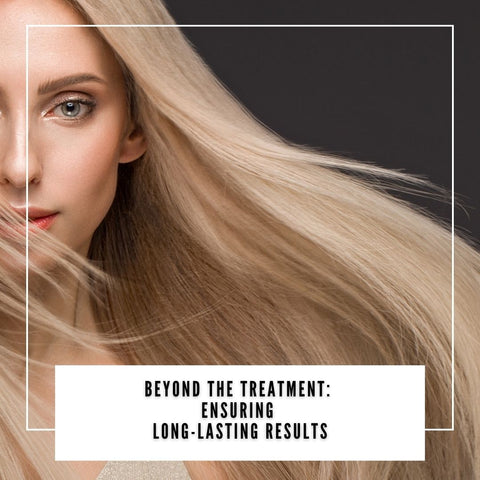
To ensure long-term results from a cysteine hair treatment, proper maintenance and care are required. Here are some tips to help your treatment last longer: use sulfate-free shampoos and conditioners, limit washing to lukewarm water, protect from heat styling, avoid harsh chemicals, deep condition regularly, protect from environmental stressors, and schedule regular touch-up appointments. By incorporating these tips into your hair care routine, you can extend the effectiveness of your cysteine hair treatment and keep your hair looking smooth, healthy, and fabulous for longer. Consistent maintenance and proper care are essential for achieving long-term results and reaping the full benefits of your treatment.



